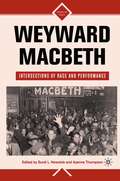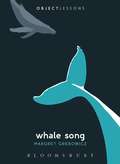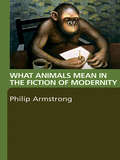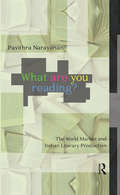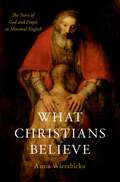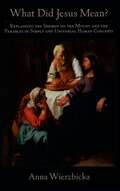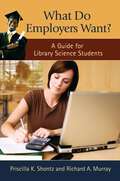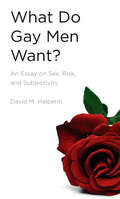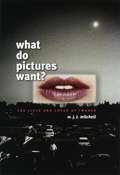- Table View
- List View
Wetland Cultures: Ancient, Traditional, Contemporary (Literatures, Cultures, and the Environment)
by Rod GiblettTraditional cultures have a long and vital association with wetlands as sacred places imbued with spiritual and ceremonial significance that provide physical sustenance and sources of materials in paludiculture. Ancient Greek and Roman cultures denigrated wetlands as places of disease, terror, horror, the hellish and the monstrous. Judeo-Christian theology was syncretized with them into the mainstream denigration of wetlands. Wetlands are a marginalized community, an oppressed minority and non-binary, queer bodies of water.
Wettbewerb im deutschen TV-Produktionssektor: Produktionsprozesse, Innovationsmanagement und Timing-Strategien (The Business of Entertainment. Medien, Märkte, Management)
by Christian ZabelGeleitwort Einige Jahre habe ich die vorliegende Arbeit von Christian Zabel in ihrem E- stehungsprozess begleitet, ich habe sie wie eine Zwiebel wachsen sehen und oft hatte ich gedacht, die Arbeit sei nun fertig gestellt. Christian Zabel hat indes einen Hang zum Perfekten und im Laufe der Jahre immer neue Schichten um den Kern des ökonomischen Programmwettbewerbs hinzugefügt, neuere Theorien verarbeitet, Ansätze aus anderen Wissenschaften einbezogen und seine empi- sche Grundlage stetig erweitert. Kern der Arbeit ist die Analyse des Wettbewerbs im Fernseh-Produktio- sektor. Dies ist äußerst verdienstvoll, weil die TV-Input-Produktion von zentraler wirtschaftlicher, strategischer und publizistischer Bedeutung ist, gleichwohl vom Mainstream der medienökonomischen Forschung kaum beachtet wird. Christian Zabel wählt das Analyseinstrumentarium der Industrieökonomik, um die Bes- derheiten dieses Wettbewerbs in einen einheitlichen Bezugsrahmen zu stellen, erweitert diesen Ansatz indes um spezifische Konzepte der Publizistik und der Organisationssoziologie. Hier zeigt sich deutlich, dass er als Diplom-Journalist sowohl Kommunikationswissenschaftler als auch Wirtschaftswissenschaftler ist, und beide Wissenschaften sehr fruchtbar integriert. Zudem ist er, der unter an- rem mehrere Jahre als Leiter der Forschungsabteilung von HMR International arbeitete, ein ausgemachter Kenner der Fernseh-Produktionsbranche.
Weyward Macbeth: Intersections of Race and Performance (Signs of Race)
by Ayanna Thompson S. NewstokWeyward Macbeth, a volume of entirely new essays, provides innovative, interdisciplinary approaches to the various ways Shakespeare's 'Macbeth' has been adapted and appropriated within the context of American racial constructions. Comprehensive in its scope, this collection addresses the enduringly fraught history of 'Macbeth' in the United States, from its appearance as the first Shakespearean play documented in the American colonies to a proposed Hollywood film version with a black diasporic cast. Over two dozen contributions explore 'Macbeth's' haunting presence in American drama, poetry, film, music, history, politics, acting, and directing — all through the intersections of race and performance.
Whale Song (Object Lessons)
by Margret GrebowiczObject Lessons is a series of short, beautifully designed books about the hidden lives of ordinary things. The sapiens of the sea, whales are the other intelligent, social, and loquacious animal. But they seem to swim away the more people chase after them in an effort to communicate and connect. Why does the meaning of their mesmerizing songs continue to elude us? In times of unprecedented environmental and social loss, Whale Song ponders the problems facing ocean ecosystems and offers lessons from those depths for human social life and intimacy. Object Lessons is published in partnership with an essay series in The Atlantic.
Whale Song (Object Lessons)
by Margret GrebowiczObject Lessons is a series of short, beautifully designed books about the hidden lives of ordinary things. The sapiens of the sea, whales are the other intelligent, social, and loquacious animal. But they seem to swim away the more people chase after them in an effort to communicate and connect. Why does the meaning of their mesmerizing songs continue to elude us? In times of unprecedented environmental and social loss, Whale Song ponders the problems facing ocean ecosystems and offers lessons from those depths for human social life and intimacy. Object Lessons is published in partnership with an essay series in The Atlantic.
Whales, Candlelight, And Stuff Like That: General Extenders In English Discourse
by Maryann OverstreetThis innovative work provides the first comprehensive account of general extenders ("or something," "and stuff," "or whatever"). Combining insights from linguistics, cognitive psychology, and interactional sociolinguistics, the author demonstrates that these small phrases are not simply vague expressions, but have a powerful role in making interpersonal communication work. The audience for this book includes linguists, scholars of English, teachers of English as a first and a second language, sociolinguists, psycholinguists, and communications researchers.
Whales, Candlelight, and Stuff Like That: General Extenders in English Discourse (Oxford Studies in Sociolinguistics)
by Maryann OverstreetThis innovative work provides the first comprehensive account of general extenders ("or something," "and stuff," "or whatever"). Combining insights from linguistics, cognitive psychology, and interactional sociolinguistics, the author demonstrates that these small phrases are not simply vague expressions, but have a powerful role in making interpersonal communication work. The audience for this book includes linguists, scholars of English, teachers of English as a first and a second language, sociolinguists, psycholinguists, and communications researchers.
Whare de yea belang?: A Dictionary of North East Dialect (G - Reference,information And Interdisciplinary Subjects Ser.)
by Bill GriffithsWhere de yea belang?brings together the distinctive vocabulary of the North East dialect. "Abackabeyont, bait-poke, cracket, drucken, etten, fettle, guissie pigs, lonnin, marra, nyen, plote, queen-cat, reckling, skinch, tew, upcast, vine, willok, yem, zookers!" If you enjoy finding out about dialect words – how and where and when they were used – and where they came from – this is the best guide to help you explore the world of North East dialect. Until the 20th century, dialect was a marker of economic, social and cultural change. We know that the North East maritime connections with the Dutch led to the introduction of many 'new' words. The Scottish influence of the keelmen (fisherman) on the Tyne and their effect on local language was much more radical. Although the Tyneside dialect and identity and this way of speaking is fast waning, the popularity of discovering this language and dialect shows there is still a great interest in the languages and dialect of the past. The late Bill Griffiths (1948–2007)was an extraordinary writer and poet: radical, experimental and scholarly, but also had a great sense of humour. He was a wonderful champion of the North East, its people and heritage. Born in Middlesex, he read history before graduating in 1969. Bill ran his own independent press and published political pamphlets and essays on the arts and poetry. After gaining a PhD in Old English he fled London and settled in Seaham where he embraced the northern way of life. 'He was also a scholar of Old English and dialect who know how to make his work accessible. Private and uncompetitive, he was at least these things: poet, archivist, scholar, translator, prison-rights campaigner, pianist, historian, curator, performer, editor, short-story writer, essayist, teacher, book-maker and lyricist. The Saturday before he died, Bill discharged himself from hospital to host the Dialect Day at the Morden Tower in Newcastle upon Tyne. He died as he lived: cataloguing, awarding Best Dialect prizes, opera on his radio, the poetry paramount.' Obituary, The Independent, 20 September 2007.
What a Novel Idea
by Katherine Wiesolek KutaEach of the sixty reproducible classroom-ready activities has general guidelines that describe the purposes for the project, how to use it, evaluation points, and variations that increase student participation and motivation, and a variety of assessment activities. Designed around the new IRA/NCTE Standards, (reading, writing, representing, viewing, speaking, and listening) these stimulating activities applicable to a variety of novels create opportunities for students to develop their skills as readers, writers, and speakers. Three sections center on reading and writing activity projects (e.g., essays, news stories, letters), visual display projects (e.g., charts, posters, bookmarks), and speaking and listening activities.
What Animals Mean in the Fiction of Modernity
by Philip ArmstrongWhat Animals Mean in the Fiction of Modernity argues that nonhuman animals, and stories about them, have always been closely bound up with the conceptual and material work of modernity. In the first half of the book, Philip Armstrong examines the function of animals and animal representations in four classic narratives: Robinson Crusoe, Gulliver’s Travels, Frankenstein and Moby-Dick. He then goes on to explore how these stories have been re-worked, in ways that reflect shifting social and environmental forces, by later novelists, including H.G. Wells, Upton Sinclair, D.H. Lawrence, Ernest Hemingway, Franz Kafka, Brigid Brophy, Bernard Malamud, Timothy Findley, Will Self, Margaret Atwood, Yann Martel and J.M. Coetzee. What Animals Mean in the Fiction of Modernity also introduces readers to new developments in the study of human-animal relations. It does so by attending both to the significance of animals to humans, and to animals’ own purposes or designs; to what animals mean to us, and to what they mean to do, and how they mean to live.
What Animals Mean in the Fiction of Modernity
by Philip ArmstrongWhat Animals Mean in the Fiction of Modernity argues that nonhuman animals, and stories about them, have always been closely bound up with the conceptual and material work of modernity. In the first half of the book, Philip Armstrong examines the function of animals and animal representations in four classic narratives: Robinson Crusoe, Gulliver’s Travels, Frankenstein and Moby-Dick. He then goes on to explore how these stories have been re-worked, in ways that reflect shifting social and environmental forces, by later novelists, including H.G. Wells, Upton Sinclair, D.H. Lawrence, Ernest Hemingway, Franz Kafka, Brigid Brophy, Bernard Malamud, Timothy Findley, Will Self, Margaret Atwood, Yann Martel and J.M. Coetzee. What Animals Mean in the Fiction of Modernity also introduces readers to new developments in the study of human-animal relations. It does so by attending both to the significance of animals to humans, and to animals’ own purposes or designs; to what animals mean to us, and to what they mean to do, and how they mean to live.
What are you Reading?: The World Market and Indian Literary Production
by Pavithra NarayananThis book offers a material critique on various aspects of Indian literary production and its reception by its audiences. Taking a historical and contemporary lineage into account, the author variously discusses the social, political, and economic factors that impact upon and determine choices in the publishing world. Examining the constructions of the archive of postcolonial works by Indian writers in relation to nationalist histories, language wars, and the relationship between economic policies and literature, the book forcefully argues that why we read what we read is more than coincidental. Placing the rights of minoritized and disadvantaged communities at the heart of the analysis of India’s decolonization and industrial projects, the book attempts to address not just inequalities in the publishing world, but also social inequities engendered by global capitalism. Offering a critique of academics who act as cultural gatekeepers of intellectual production, the book finally underscores the disconnect between the academic theory and practice of scholars of postcolonial studies who argue against inequality and marginalization while simultaneously supporting hegemonic academic practices. This book will be of interest to scholars of development studies, cultural studies, literature, postcolonial studies, economics, and those studying globalization, as well as the interested lay reader.
What are you Reading?: The World Market and Indian Literary Production
by Pavithra NarayananThis book offers a material critique on various aspects of Indian literary production and its reception by its audiences. Taking a historical and contemporary lineage into account, the author variously discusses the social, political, and economic factors that impact upon and determine choices in the publishing world. Examining the constructions of the archive of postcolonial works by Indian writers in relation to nationalist histories, language wars, and the relationship between economic policies and literature, the book forcefully argues that why we read what we read is more than coincidental. Placing the rights of minoritized and disadvantaged communities at the heart of the analysis of India’s decolonization and industrial projects, the book attempts to address not just inequalities in the publishing world, but also social inequities engendered by global capitalism. Offering a critique of academics who act as cultural gatekeepers of intellectual production, the book finally underscores the disconnect between the academic theory and practice of scholars of postcolonial studies who argue against inequality and marginalization while simultaneously supporting hegemonic academic practices. This book will be of interest to scholars of development studies, cultural studies, literature, postcolonial studies, economics, and those studying globalization, as well as the interested lay reader.
What are you staring at?: A Comic About Restorative Justice in Schools (PDF)
by Joseph Wilkins Pete WallisDesigned for use in schools, this comic teaches children about restorative justice through the story of Jake and Ryan. After a misunderstanding between Jake and Ryan leads to a fight in the playground, both boys are left feeling angry and fearful about what might happen when they see each other again. Rather than keeping Jake and Ryan apart, their teacher arranges a restorative meeting to allow the boys to understand the situation from the other's perspective and transform their negative emotions into positive ones. This comic is a key resource in helping children aged 8-13 to understand restorative justice and prepare for a restorative meeting. The comic also features a resource section for teachers, explaining more about restorative practices and how they can be used in schools to foster respect and emotional literacy among students.
What Christians Believe: The Story of God and People in Minimal English
by Anna WierzbickaMany people today, both Christians and non-Christians, are confused about or unaware of the essentials of Christian faith. In this book, Anna Wierzbicka takes a radically new approach to the task of communicating "what Christians believe" to the widest possible audience. "The Story of God and People," the heart of the book, sets out the core tenets of Christian faith in narrative form using simple language that is accessible to anyone, even those with no familiarity with Christianity or Christian vocabulary. The Story is not only simple but also universal: though written in English, it is not phrased in full English--English as we know it today, shaped by history, culture, and tradition--but in "Minimal English." Minimal English contains only those 400 or so English words that can be translated into any other language; essentially, it corresponds to the shared core of all languages. In the introduction to the book, Wierzbicka explains Minimal English and minimal languages in general, and in "The Story of God and People" that follows, she demonstrates the effectiveness of Minimal English as a tool for global understanding. At the same time, the use of Minimal English allows her not only to retell the Christian story in a strikingly new way, but also to rethink its meaning, bringing into relief its internal cohesion, logic and beauty.
What Christians Believe: The Story of God and People in Minimal English
by Anna WierzbickaMany people today, both Christians and non-Christians, are confused about or unaware of the essentials of Christian faith. In this book, Anna Wierzbicka takes a radically new approach to the task of communicating "what Christians believe" to the widest possible audience. "The Story of God and People," the heart of the book, sets out the core tenets of Christian faith in narrative form using simple language that is accessible to anyone, even those with no familiarity with Christianity or Christian vocabulary. The Story is not only simple but also universal: though written in English, it is not phrased in full English--English as we know it today, shaped by history, culture, and tradition--but in "Minimal English." Minimal English contains only those 400 or so English words that can be translated into any other language; essentially, it corresponds to the shared core of all languages. In the introduction to the book, Wierzbicka explains Minimal English and minimal languages in general, and in "The Story of God and People" that follows, she demonstrates the effectiveness of Minimal English as a tool for global understanding. At the same time, the use of Minimal English allows her not only to retell the Christian story in a strikingly new way, but also to rethink its meaning, bringing into relief its internal cohesion, logic and beauty.
What Did Jesus Mean?: Explaining The Sermon On The Mount And The Parables In Simple And Universal Human Concepts
by Anna WierzbickaWhat did Jesus Mean?: Explaining the Sermon on the Mount and the Parables in Simple and Universal Human Concepts
by Anna WierzbickaIn this highly interdisciplinary work, linguist Anna Wierzbicka casts new light on the words of Jesus by taking her well-known semantic theory of "universal human concepts"- concepts which are intuitively understandable and self-explanatory across languages-and bringing it to bear on Jesus' parables and the Sermon on the Mount. Her approach results in strikingly novel interpretations of the Gospels. Written in dialogue with other biblical commentators, What Did Jesus Mean? is both scholarly rigorous yet accessible.
What Do Employers Want?: A Guide for Library Science Students
by Priscilla K. Shontz Richard A. MurrayA candid, comprehensive, and insightful explanation of what library school students need to do in order to maximize their chances of getting a professional position immediately after graduation.While library schools provide graduates with a solid understanding of library science concepts, many diploma holders have no clear plan for finding a desirable job with their knowledge The information in What Do Employers Want? A Guide for Library Science Students will be extremely valuable for students currently in Masters of Library Science program as well as recent recipients of MLS degrees, regardless of what kind of work environment they wish to work in.The book guides readers through the process of planning a job search step-by-step. Divided into two major sections—the student experience and the job search—the authors provide critical advice derived from their combined 30 years of real-world, in-the-field experience. Specific topics include choosing classes, gaining practical experience while in school, establishing a professional image, gaining skills that make applicants more marketable, writing effective resumes and cover letters, interviewing, and negotiating a job offer.
What Do Employers Want?: A Guide for Library Science Students
by Priscilla K. Shontz Richard A. MurrayA candid, comprehensive, and insightful explanation of what library school students need to do in order to maximize their chances of getting a professional position immediately after graduation.While library schools provide graduates with a solid understanding of library science concepts, many diploma holders have no clear plan for finding a desirable job with their knowledge The information in What Do Employers Want? A Guide for Library Science Students will be extremely valuable for students currently in Masters of Library Science program as well as recent recipients of MLS degrees, regardless of what kind of work environment they wish to work in.The book guides readers through the process of planning a job search step-by-step. Divided into two major sections—the student experience and the job search—the authors provide critical advice derived from their combined 30 years of real-world, in-the-field experience. Specific topics include choosing classes, gaining practical experience while in school, establishing a professional image, gaining skills that make applicants more marketable, writing effective resumes and cover letters, interviewing, and negotiating a job offer.
What Do Gay Men Want?: An Essay on Sex, Risk, and Subjectivity
by David Halperin“Compelling, timely, and provocative. The writing is sleek and exhilarating. It doesn’t waste time telling us what it will do or what it has just done—it just does it.” —Don Kulick, Professor of Anthropology, New York University How we can talk about sex and risk in the age of barebacking—or condomless sex—without invoking the usual bogus and punitive clichés about gay men’s alleged low self-esteem, lack of self-control, and other psychological “deficits”? Are there queer alternatives to psychology for thinking about the inner life of homosexuality? What Do Gay Men Want? explores some of the possibilities. Unlike most writers on the topic of gay men and risky sex, David Halperin liberates gay male subjectivity from psychology, demonstrating the insidious ways in which psychology’s defining opposition between the normal and the pathological subjects homosexuality to medical reasoning and revives a whole set of unexamined moral assumptions about “good” sex and “bad” sex. In particular, Halperin champions neglected traditions of queer thought, including both literary and popular discourses, by drawing on the work of well-known figures like Jean Genet and neglected ones like Marcel Jouhandeau. He shows how the long history of of gay men’s uses of “abjection” can offer an alternative, nonmoralistic model for thinking about gay male subjectivity, something which is urgently needed in the age of barebacking. Anyone searching for nondisciplinary ways to slow the spread of HIV/AIDS among gay men—or interested in new modes of thinking about gay male subjectivity—should read this book. David M. Halperin is W. H. Auden Collegiate Professor of the History and Theory of Sexuality, Professor of English, Professor of Women’s Studies, Professor of Comparative Literature, and Adjunct Professor of Classical Studies at the University of Michigan.
What Do Pictures Want?: The Lives and Loves of Images
by W. J. MitchellWhy do we have such extraordinarily powerful responses toward the images and pictures we see in everyday life? Why do we behave as if pictures were alive, possessing the power to influence us, to demand things from us, to persuade us, seduce us, or even lead us astray? According to W. J. T. Mitchell, we need to reckon with images not just as inert objects that convey meaning but as animated beings with desires, needs, appetites, demands, and drives of their own. What Do Pictures Want? explores this idea and highlights Mitchell's innovative and profoundly influential thinking on picture theory and the lives and loves of images. Ranging across the visual arts, literature, and mass media, Mitchell applies characteristically brilliant and wry analyses to Byzantine icons and cyberpunk films, racial stereotypes and public monuments, ancient idols and modern clones, offensive images and found objects, American photography and aboriginal painting. Opening new vistas in iconology and the emergent field of visual culture, he also considers the importance of Dolly the Sheep—who, as a clone, fulfills the ancient dream of creating a living image—and the destruction of the World Trade Center on 9/11, which, among other things, signifies a new and virulent form of iconoclasm. What Do Pictures Want? offers an immensely rich and suggestive account of the interplay between the visible and the readable. A work by one of our leading theorists of visual representation, it will be a touchstone for art historians, literary critics, anthropologists, and philosophers alike. “A treasury of episodes—generally overlooked by art history and visual studies—that turn on images that ‘walk by themselves’ and exert their own power over the living.”—Norman Bryson, Artforum
What Do Pictures Want?: The Lives and Loves of Images (Prehistoric Archeology And Ecology Ser.)
by W. J. MitchellWhy do we have such extraordinarily powerful responses toward the images and pictures we see in everyday life? Why do we behave as if pictures were alive, possessing the power to influence us, to demand things from us, to persuade us, seduce us, or even lead us astray? According to W. J. T. Mitchell, we need to reckon with images not just as inert objects that convey meaning but as animated beings with desires, needs, appetites, demands, and drives of their own. What Do Pictures Want? explores this idea and highlights Mitchell's innovative and profoundly influential thinking on picture theory and the lives and loves of images. Ranging across the visual arts, literature, and mass media, Mitchell applies characteristically brilliant and wry analyses to Byzantine icons and cyberpunk films, racial stereotypes and public monuments, ancient idols and modern clones, offensive images and found objects, American photography and aboriginal painting. Opening new vistas in iconology and the emergent field of visual culture, he also considers the importance of Dolly the Sheep—who, as a clone, fulfills the ancient dream of creating a living image—and the destruction of the World Trade Center on 9/11, which, among other things, signifies a new and virulent form of iconoclasm. What Do Pictures Want? offers an immensely rich and suggestive account of the interplay between the visible and the readable. A work by one of our leading theorists of visual representation, it will be a touchstone for art historians, literary critics, anthropologists, and philosophers alike. “A treasury of episodes—generally overlooked by art history and visual studies—that turn on images that ‘walk by themselves’ and exert their own power over the living.”—Norman Bryson, Artforum
What Do Pictures Want?: The Lives and Loves of Images
by W. J. MitchellWhy do we have such extraordinarily powerful responses toward the images and pictures we see in everyday life? Why do we behave as if pictures were alive, possessing the power to influence us, to demand things from us, to persuade us, seduce us, or even lead us astray? According to W. J. T. Mitchell, we need to reckon with images not just as inert objects that convey meaning but as animated beings with desires, needs, appetites, demands, and drives of their own. What Do Pictures Want? explores this idea and highlights Mitchell's innovative and profoundly influential thinking on picture theory and the lives and loves of images. Ranging across the visual arts, literature, and mass media, Mitchell applies characteristically brilliant and wry analyses to Byzantine icons and cyberpunk films, racial stereotypes and public monuments, ancient idols and modern clones, offensive images and found objects, American photography and aboriginal painting. Opening new vistas in iconology and the emergent field of visual culture, he also considers the importance of Dolly the Sheep—who, as a clone, fulfills the ancient dream of creating a living image—and the destruction of the World Trade Center on 9/11, which, among other things, signifies a new and virulent form of iconoclasm. What Do Pictures Want? offers an immensely rich and suggestive account of the interplay between the visible and the readable. A work by one of our leading theorists of visual representation, it will be a touchstone for art historians, literary critics, anthropologists, and philosophers alike. “A treasury of episodes—generally overlooked by art history and visual studies—that turn on images that ‘walk by themselves’ and exert their own power over the living.”—Norman Bryson, Artforum
What Do Pictures Want?: The Lives and Loves of Images
by W. J. MitchellWhy do we have such extraordinarily powerful responses toward the images and pictures we see in everyday life? Why do we behave as if pictures were alive, possessing the power to influence us, to demand things from us, to persuade us, seduce us, or even lead us astray? According to W. J. T. Mitchell, we need to reckon with images not just as inert objects that convey meaning but as animated beings with desires, needs, appetites, demands, and drives of their own. What Do Pictures Want? explores this idea and highlights Mitchell's innovative and profoundly influential thinking on picture theory and the lives and loves of images. Ranging across the visual arts, literature, and mass media, Mitchell applies characteristically brilliant and wry analyses to Byzantine icons and cyberpunk films, racial stereotypes and public monuments, ancient idols and modern clones, offensive images and found objects, American photography and aboriginal painting. Opening new vistas in iconology and the emergent field of visual culture, he also considers the importance of Dolly the Sheep—who, as a clone, fulfills the ancient dream of creating a living image—and the destruction of the World Trade Center on 9/11, which, among other things, signifies a new and virulent form of iconoclasm. What Do Pictures Want? offers an immensely rich and suggestive account of the interplay between the visible and the readable. A work by one of our leading theorists of visual representation, it will be a touchstone for art historians, literary critics, anthropologists, and philosophers alike. “A treasury of episodes—generally overlooked by art history and visual studies—that turn on images that ‘walk by themselves’ and exert their own power over the living.”—Norman Bryson, Artforum


